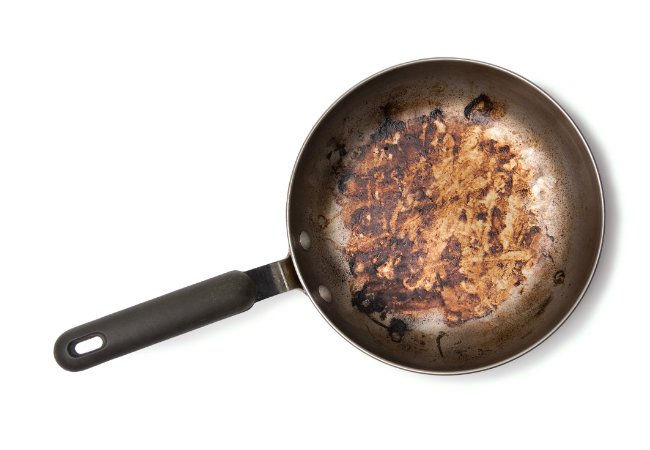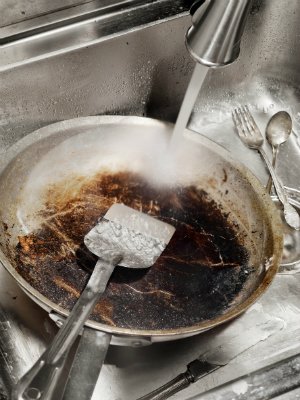

We may earn revenue from the products available on this page and participate in affiliate programs. Learn More ›
Whether you’re caramelizing onions, simmering a sugary fruit jam, or baking homemade biscuits, your culinary masterpiece can quickly turn into a burnt meal or dessert if the pot or pan is unattended and left to overheat. Worse than chomping down on a charcoaled or extra-crispy entrée is cleaning up the charred mess of stuck-on food left behind in the pot, sauce pan, or baking sheet used to cook it. Although commercial solvents promising to clean burnt pans do exist, some can introduce chemicals into your cooking or even damage the delicate surface of your stainless steel or ceramic cookware. Fortunately, with natural household ingredients and this guide on how to clean burnt pans, you can safely wash up scorched pots and pans, prolong the life of your cookware, and—most importantly—get cooking again!
Tools & Materials
Bobvila.com may earn a commission from purchases made through these links.

Step 1
Turn off the stove and allow the burnt pans or pots to cool completely before handling them. Then, use a wooden spoon to gently scrape off and discard any large, loose food particles from the cookware into the trash.
Step 2
With only the burnt residue left in the pans, place the emptied pans on the cool stovetop and fill each with a cup each of water and white vinegar. You want the burnt food debris to be fully submerged under the liquid. For larger pans in which the food stain is still exposed, continue to add water and vinegar in equal parts until the liquid covers the full extent of the stains.
Turn on the stove burners and bring the water-vinegar solution to a rapid boil. Allow the solution to boil for 10 minutes. Then, turn off the stove and transfer the pans to a cool surface. (If your countertop surface is susceptible to heat damage, be sure to place these pans on individual trivets.)
Step 3
While the water-vinegar solution is still hot, add in two tablespoons of baking soda to each pan to be cleaned. The solution will begin to fizz, signaling that the chemical reaction of the two handy household cleaners is at work dissolving any burnt remains in the pans. But rest assured that even though baking soda is tough on food residue, it is a mild abrasive agent that won’t scratch the bottom of your stainless steel or ceramic cookware.
If your pans bear particularly stubborn stains that the boiling process did not loosen substantially, add up to one more tablespoon of baking soda in each.
Note: While baking soda is safe for use on stainless steel or ceramic cookware, you should never use alkaline-based cleaning agents like baking soda on anodized aluminum cookware, as it can react negatively with the pan coating. If you’re cleaning up aluminum pans, skip this step altogether and proceed to Step 4.

Step 4
Discard the water-vinegar solution from the pans into the sink. Unlike specialized cleaners that contain chemicals, baking soda is natural and safe for consumption, so small traces of excess baking soda can’t hurt you if cooked into your next meal. But you don’t want to leave the water-vinegar solution to dwell too long in a pan because stainless steel pans in particular are prone to develop hard water stains.
Step 5
Gather a soft sponge or a non-scratch scouring pad and slowly and gently scrub the stained areas. Avoid using steel wool or another metal scouring pad on your pans, as their abrasive texture can scratch or damage your stainless steel or enamel cookware with repeat usage.
With a little elbow grease, the food residue should readily come off pots and pans with the sponge. If any stubborn residue lingers, sprinkle a pinch of baking soda over the offending area and then vigorously scrub it again for up to a minute to lift the residue. The baking soda will both polish and add a soft shine to your cookware.
Step 6
Rinse the clean pans under cold water to discard the loosened food particles. Then, let them dry completely before storing.
In the future, keep a close eye—and a kitchen timer—on finicky foods to prevent them from burning. If kitchen accidents do happen, you now have a proven technique to clean up after them.
The above method works well for cleaning burnt pans, but did you know that Coca-Cola can also get the job done? To learn more, check out our video below.
